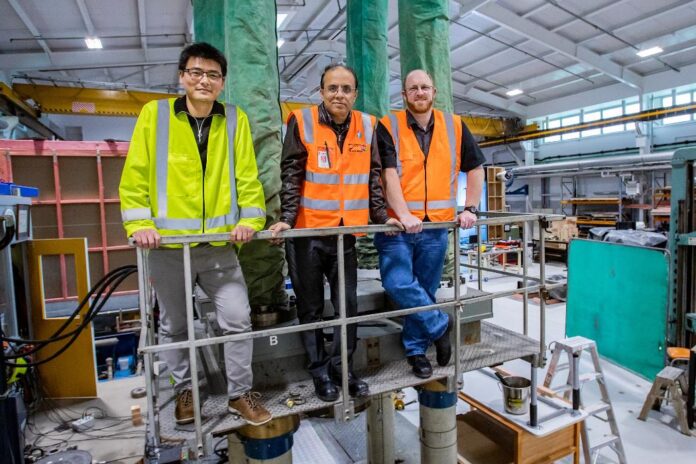Source: University of Canterbury
08 July 2021
New Zealand engineering researchers are working on an innovative modular system to revolutionise the way we construct buildings; not just more rapidly, but also more environment-friendly, quake-resilient and recyclable.
-
University of Canterbury Engineering Professor Rajesh Dhakal (centre) and Professor Geoff Rodgers (right), along with Dr Brian Guo (left), are developing a rapid, reduced-carbon, resilient and recyclable Modular Building System.
A group of experts from New Zealand’s construction industry and research institutes are being led by University of Canterbury academics, Professor Rajesh Dhakal, a leading earthquake engineering expert whose innovative research has inspired seismic design practice worldwide, and Professor Geoff Rodgers whose low-damage seismic designs are integrated into large buildings around the world, including Christchurch’s Tūranga Library and Forte Health buildings.
Along with fellow UC engineering academics, construction management expert Dr Brian Guo and structural modelling and analysis expert Dr Reagan Chandramohan, they’ve called their innovative project ‘Rapid, Reduced-carbon, Resilient and Recyclable Modular Building System’ – or R4MBS for short.
The engineering professors aim to develop a novel building system of standardised prefabricated structural modules connected using detachable low-damage steel connections.
“It will herald a paradigm-shift in the building sector by placing explicit emphases on construction efficiency and environmental impact, in addition to the building’s seismic resilience and reduced lifecycle carbon-footprint,” says Professor Dhakal.
Concrete buildings are traditionally cast monolithically, which renders them slow and expensive to construct, difficult to repair or strengthen, impossible to recycle, and prone to costly, hazardous and/or wasteful demolition.
“Even steel and timber buildings employing monolithic connections to reinforced-concrete floor-slabs suffer from these issues,” says Professor Rodgers.
R4MBS will offer numerous benefits over traditional building systems:
- rapid on-site assembly, minimising construction time, costs, and hazards
- reduced building lifecycle carbon-footprint by increasing production and construction efficiencies, reducing material usage, avoiding demolition, and facilitating recycling
- easy upgrading and strengthening whenever needed
- damage-free performance under moderate earthquakes
- under severe earthquakes, any damaged parts can be easily repaired/replaced to quickly restore the building
This project will combine experimental testing, construction-sequence modelling, life-cycle analysis, and numerical simulations to establish the efficiency and superiority of the new construction paradigm. It will:
- standardise configurations of R4MBS elements and connections for easy and rapid assembly (and disassembly) as well as high seismic resilience
- optimise R4MBS’s assembly, repair, and disassembly workflow sequence to maximise the efficiency gains
- minimise the environmental impact of R4MBS through life-cycle analyses
- demonstrate R4MBS’s superior seismic performance through state-of-the-art large-scale experimental testing
- develop design/construction guidance to facilitate smooth adoption of R4MBS in NZ building industry
For more information please contact:
Professor Rajesh Dhakal, Civil and Natural Resources Engineering, University of Canterbury rajesh.dhakal@canterbury.ac.nz Phone: +64 3 369 5948 0277428541,
Professor Geoff Rodgers, Mechanical Engineering, University of Canterbury geoff.rodgers@canterbury.ac.nz Phone: +64 3 369 2270,
or
UC Communications team, media@canterbury.ac.nz, Ph: (03) 369 3631 or 027 503 0168



